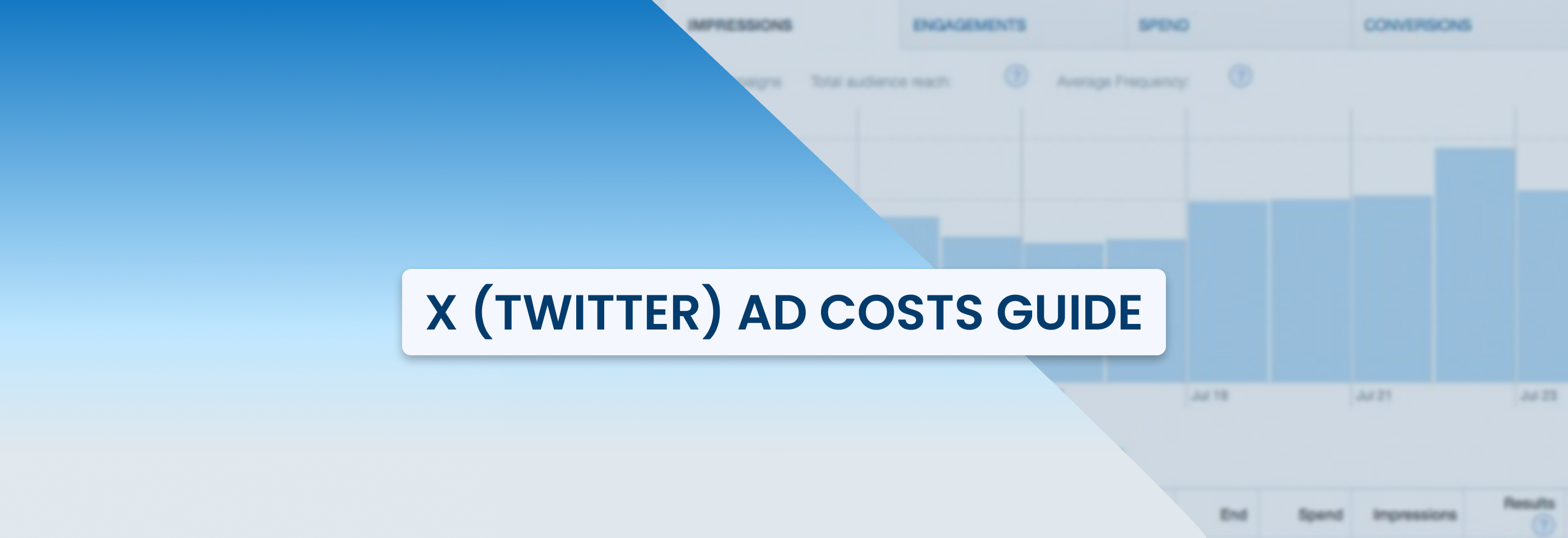What is Email Marketing and How to Use It Right
2025-03-14
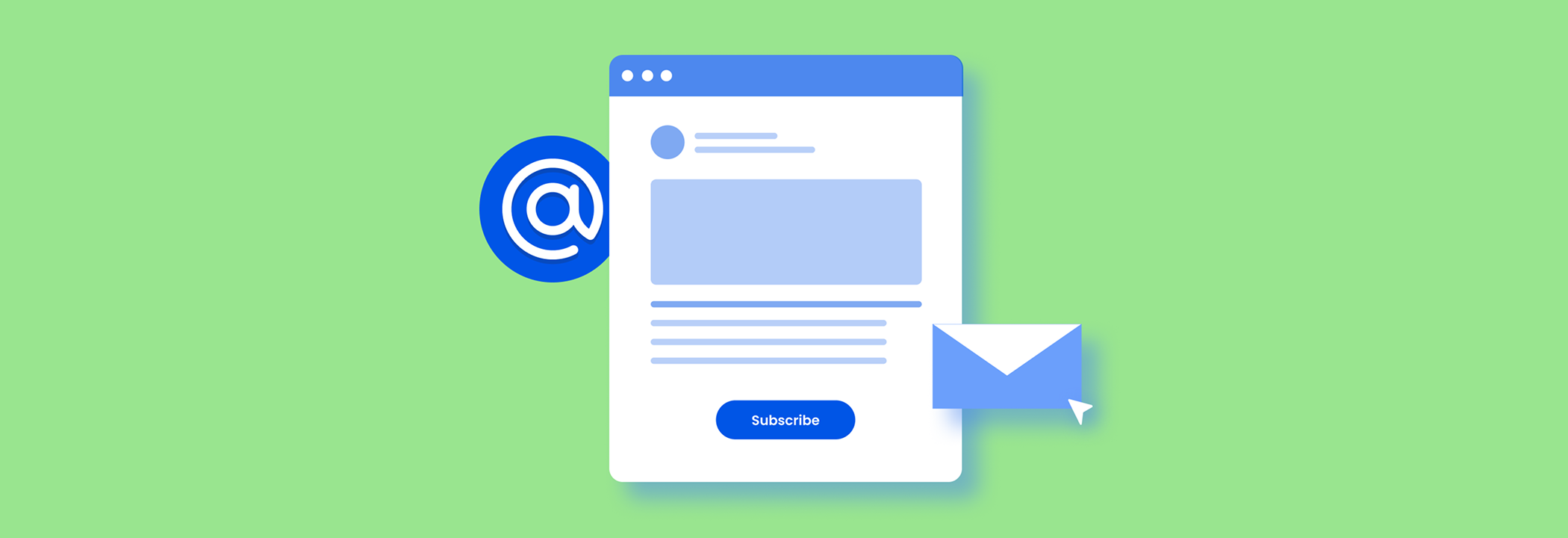
Email marketing is one of the most effective ways to connect with your audience, drive sales, and build lasting relationships. But it’s more than just sending emails — you need to have the right strategy to make it work.
In this guide, we’ll cover what email marketing is, its benefits, the key types of emails you can send, and strategies to grow your email list and send relevant emails that drive engagement and conversions.
What is email marketing?
Email marketing is a direct, strategic way to connect with your audience, drive engagement, and boost sales. It’s not just sending emails, but doing it strategically: with the right goal in mind, a relevant audience, and a matching design.
The days of mass, one-size-fits-all emails are over. Today, the key to success is personalization and segmentation.
Brands now create email sequences based on user behavior, interests, purchase history, and other factors, making their messages more relevant and engaging. And they look pretty great too — there are many examples of creative and aesthetic emails out there, some of which you can probably find in your inbox.
Benefits of email marketing
Why does email marketing matter? With over 4 billion global email users worldwide and 93% of people using email every day, it’s a channel that businesses can’t ignore.
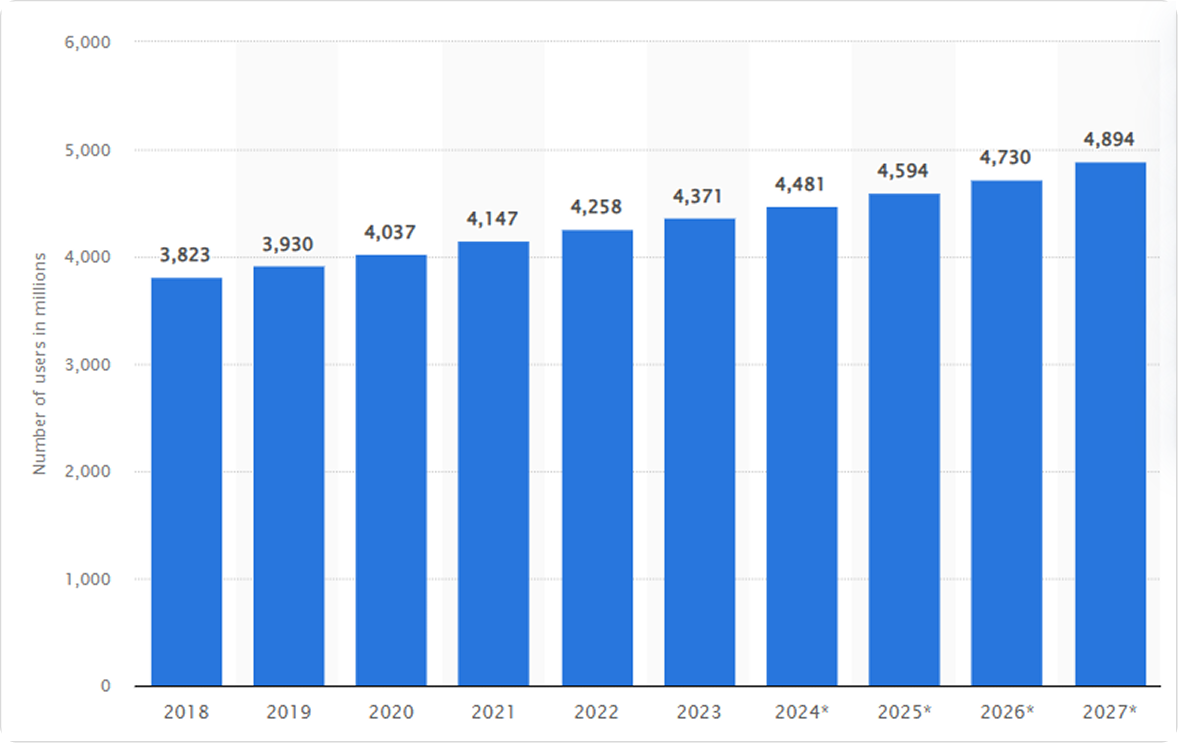
Number of email users worldwide from 2018 to 2027. Source: Statista
While social media often steals the spotlight, email offers some key advantages that make it an essential tool for marketers. Here’s why:
1. You reach people directly
With social media, your message can get buried under endless posts and unpredictable algorithms. With email marketing, you don’t have to be at the mercy of algorithms — email puts you in direct contact with your subscribers.
Email goes straight to your audience’s inbox, which means your message has a higher chance of being seen and acted on. And if your emails are relevant and engaging, people might expect to receive updates from you.
2. Email converts better than most channels
Email consistently outperforms other marketing channels when it comes to turning leads into sales.
According to HubSpot’s State of Marketing Report, email marketing is the highest ROI strategy for most B2C brands, outperforming paid social media and content marketing.
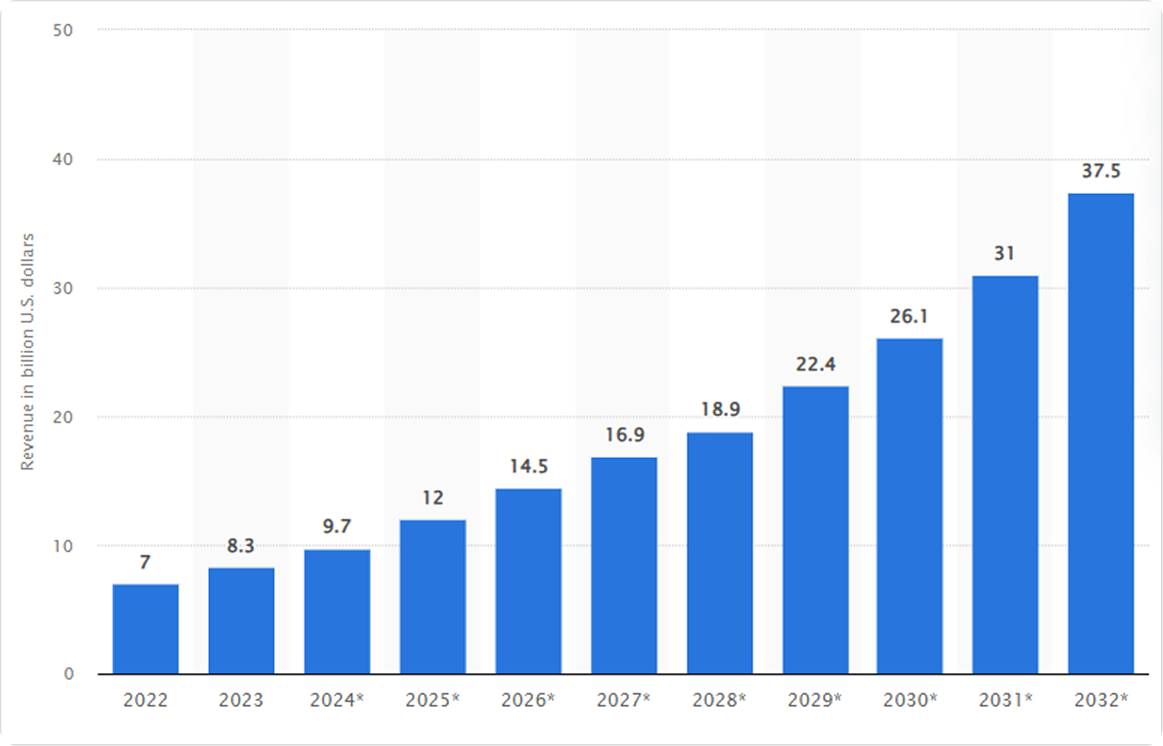
E-mail marketing revenue worldwide from 2022 to 2032. Source: Statista
Emails, whether they’re reminding customers about abandoned carts, offering limited-time deals, or recommending products, inspire action.
3. It’s cost-effective
Email marketing is far more budget-friendly compared to advertising and content marketing.
According to WebFX, the majority of businesses spend no more than $750 a month on email marketing. Compare that to how much they spend on online advertising and content marketing (hint: a lot more), and you’ll understand why so many businesses use email marketing as one of their main strategies.
You can reach thousands — or even millions — for a fraction of the cost of paid ads, making it one of the best returns on investment in marketing.
4. It helps build customer loyalty
Email is more than just about selling — it’s about building relationships. Regular updates, personalized offers, and helpful content keep your brand top of mind and encourage ongoing engagement.
5. You can track what works
Just like with advertising and creating content, you don’t have to guess what’s working. Email open rates, click-through rates, and conversions will tell you exactly how your audience is responding. This makes it easy to optimize your email campaigns and get better results over time.
6. It works with other marketing channels
Also, email doesn’t have to work alone — it can boost everything else you’re doing. You can use emails to send people to your website, promote social media content, highlight upcoming events, and a lot more.
When combined with other strategies, email helps create a stronger, more connected marketing approach.
In short, email marketing is one of the best ways to engage customers, drive sales, and grow your brand without spending a lot. If you’re looking for a marketing channel that’s reliable, cost-effective, and high-converting, email should be at the top of your list.
But while email marketing offers huge benefits, not all emails get the attention they deserve.
The average email open rate across industries is 36.5%, meaning more than a third of all emails reach their recipients. However, as eMarketer shows, most people still ignore or delete emails from brands — only the best and most relevant emails get into the center of people’s attention.
You need the right messaging, design, and timing to stand out from the dozens of emails people receive daily. In short, you need effective email marketing strategies.
Before we talk about them in more detail, let’s first explore the main types of marketing emails you can use to build relationships with your customers.
Types of emails you can send
1. Welcome emails
A welcome email is your business’ first interaction with a new subscriber, setting the tone for your relationship. This is your chance to introduce your business, highlight what makes you special, and get people excited to stick around.
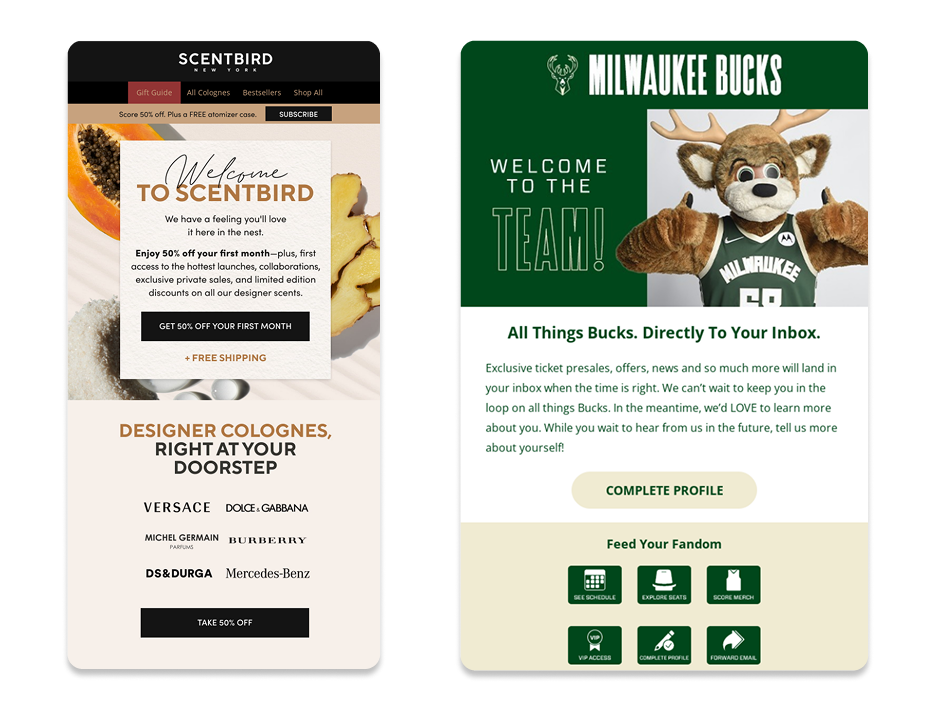
Two great tactics you can use in welcome emails — offering a special discount for the newcomers and getting to know them better
Common use cases:
- Introduce your brand — give new subscribers a quick overview of what you offer.
- Offer a first-purchase discount — a special deal can encourage them to buy right away.
- Guide people to the next step — whether it’s downloading your app, exploring your website, or following you on social media, a welcome email should help them take action.
A good welcome email provides value and gives people a reason to engage. If you get this right, your audience will be looking forward to your next email, not ignoring it.
2. Promotional emails
Promotional emails are designed to encourage immediate action. These typically feature time-sensitive offers, exclusive discounts, or new product announcements that push recipients to engage quickly.
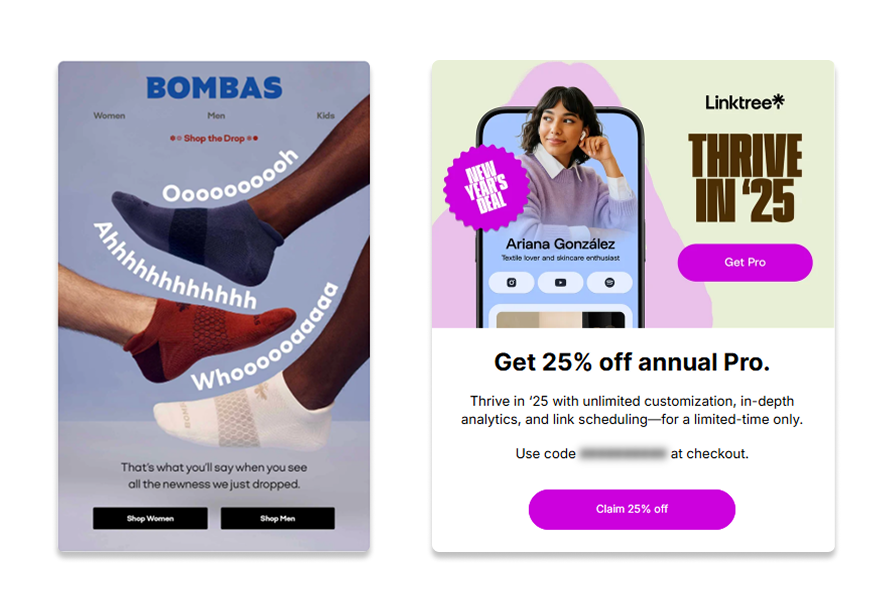
The key to an effective promotional email is to show your offer quickly to get people interested
Common use cases:
- Seasonal sales — promote discounts tied to events like Black Friday or summer sales.
- Exclusive deals — reward VIPs or offer flash sales to select customers.
- New product launches — announce fresh arrivals and get people interested.
- Holiday promotions — tie special offers to major holidays like Christmas or Valentine’s Day.
The key to a great promotional email is to make the offer clear and time-sensitive. If people feel like they might miss out, they’ll be more likely to take action right away.
3. Newsletter emails
Newsletters are a great way to stay connected with your audience and keep them interested in your brand. Whether you’re sharing company updates, industry insights, or helpful tips, these emails keep your subscribers in the loop.
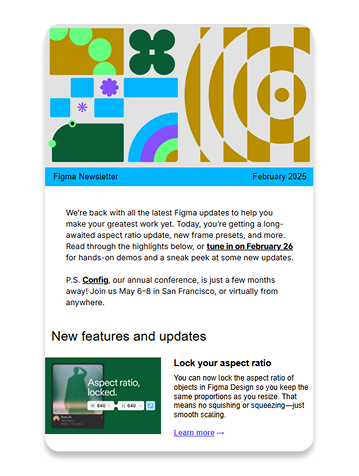
Newsletter emails can be long or short, more informative or more entertaining, etc. depending on your audience
Common use cases:
- Regular updates — share company news, product launches, or upcoming events.
- Industry insights — provide valuable tips, trends, or expert advice.
- Product news — highlight new products, updates, or features.
A well-written and designed newsletter helps you build stronger relationships with your audience over time. By consistently providing value, you keep your brand top of mind and show subscribers you care.
4. Transactional emails
Transactional emails are triggered by specific actions, like making a purchase or resetting a password. They are essential for keeping customers informed about their transactions or account updates.
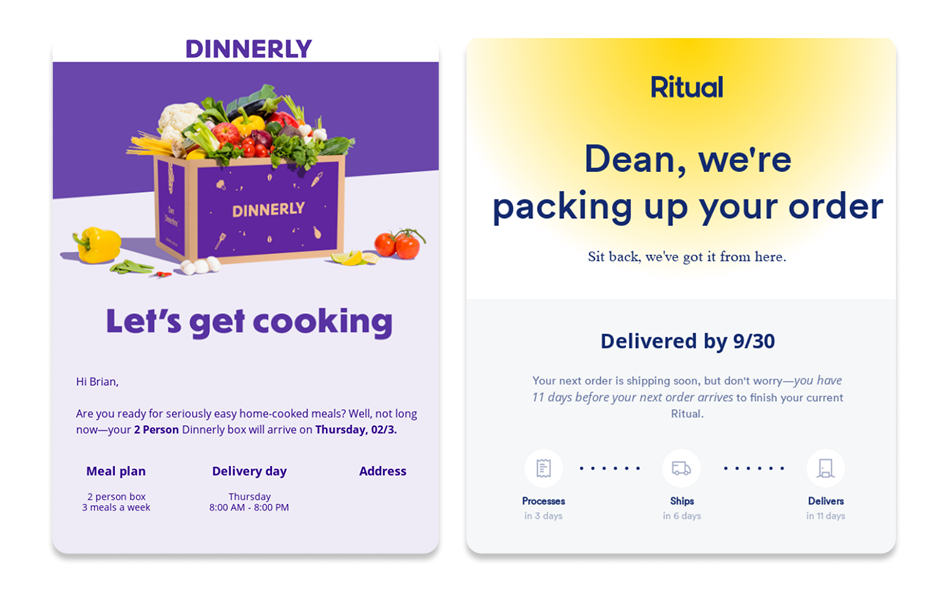
Transactional emails don't have to be boring - you can add a little character to them
Common use cases:
- Order confirmations — let customers know their purchase was successful.
- Shipping updates — provide tracking details and estimated delivery times.
- Account notifications — alert users about password resets or subscription changes.
These emails help build trust by keeping customers informed every step of the way. Since they contain essential information, they also have some of the highest open rates.
5. Re-engagement emails
Re-engagement emails are designed to bring back customers who haven’t interacted with your brand in a while. A well-timed message can spark their interest and remind them why they signed up in the first place.
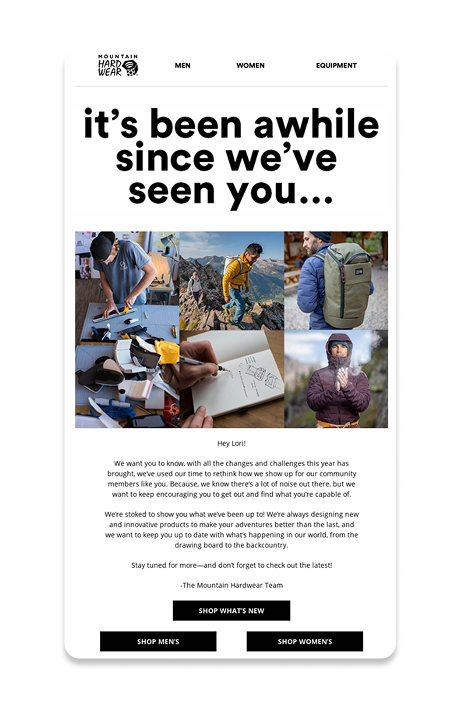
Common use cases:
- Special discounts — offer an exclusive deal to entice them back.
- Product updates — highlight new features or products they might love.
- Cart reminders — nudge them to complete their abandoned purchase.
Re-engagement emails are a great way to revive customer interest and encourage them to take action, whether that’s making a purchase, browsing new products, or re-engaging with your content.
6. Abandoned cart emails
Abandoned cart emails is a special kind of re-engagement emails that help bring back shoppers who almost checked out but didn’t complete their purchase. These emails serve as a gentle nudge to remind, incentivize, and create urgency so customers don’t leave empty-handed.
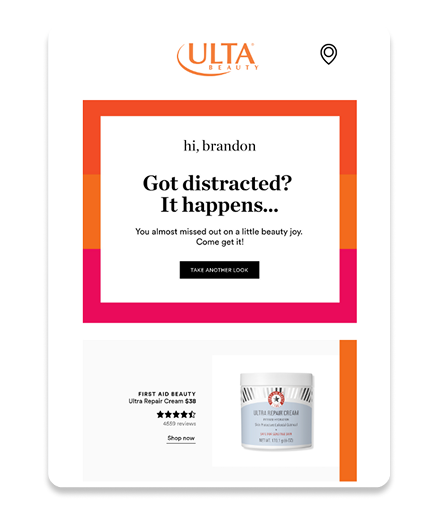
You can remind customers about the items they've browsed and offer something special to sweeten the deal
Common use cases:
- Cart reminders — show customers what they left behind.
- Incentives — offer a discount or free shipping to seal the deal.
- Urgency — let them know their items might sell out soon.
Since these emails reach people who were already interested, they have a high chance of converting. A well-timed reminder or a small incentive can be enough to bring them back and close the sale.
7. Event invitation emails
Event invitation emails are perfect for promoting both online and in-person events. They help build anticipation and encourage people to sign up and attend.
Common use cases:
- Webinars — invite people to join your live, online event.
- In-person events — promote conferences, product launches, or store openings.
- Exclusive invites — send special invitations to VIPs or influencers.
A great invitation highlights the value of attending — gaining new knowledge, networking with industry experts, or getting early access to a product. Including a clear call to action makes it easy for recipients to sign up.
8. Survey and feedback emails
Survey and feedback emails are a great way to gather valuable insights from your customers. These emails help you improve your products or services by learning directly from your audience.
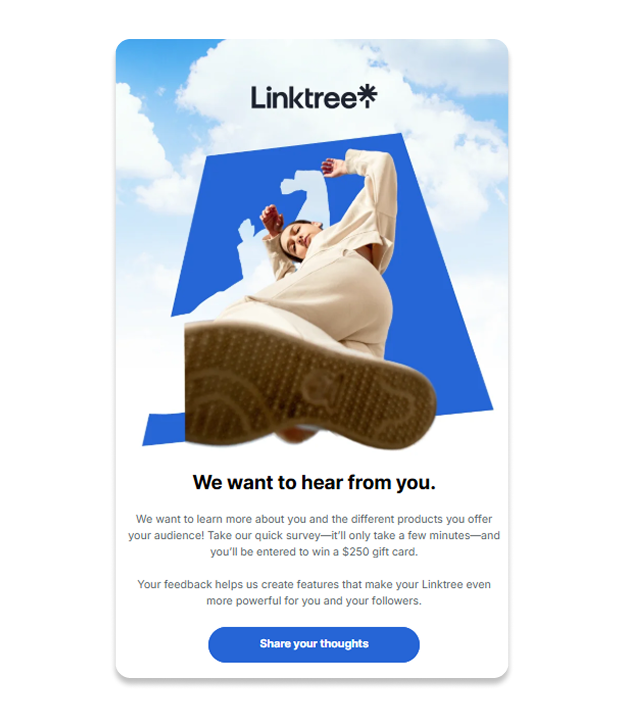
Linktree doesn't just ask users for feedback, but offers them something valuable in return
Common use cases:
- Post-purchase feedback — ask customers how their buying experience went.
- Satisfaction surveys — find out how happy customers are with your product or service.
- Product improvement polls — get opinions on new features or upcoming products.
Collecting customer feedback helps you improve your emails and also makes your customers feel valued and heard. Offering a small incentive, like a discount or entry into a giveaway, can boost your response rates.
9. Holiday and seasonal emails
Holiday and seasonal emails are perfect for making the most of peak shopping times. Whether it's Christmas or Black Friday, these emails take advantage of the seasonal excitement to boost sales.
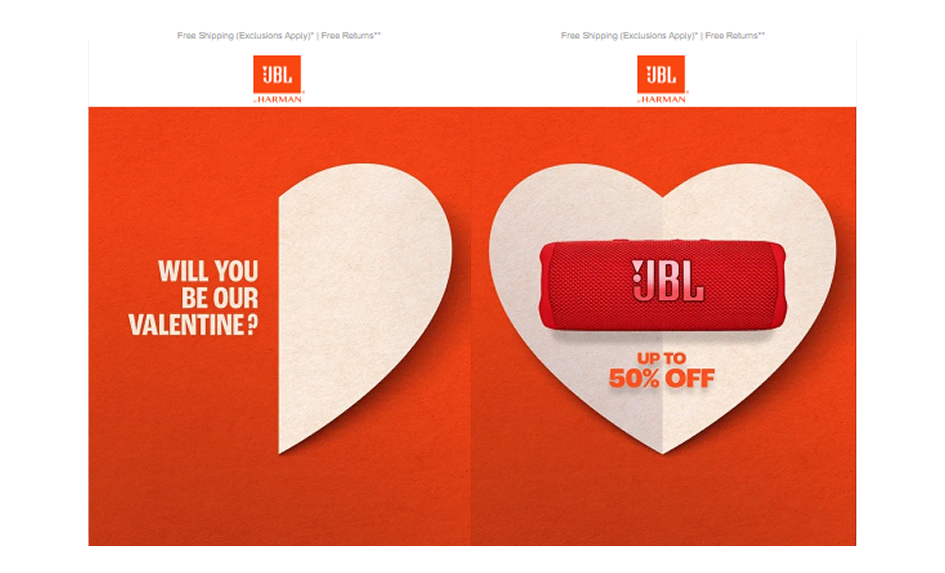 JBL used simple, but effective visuals for their Valentine's Day email
JBL used simple, but effective visuals for their Valentine's Day email
Common use cases:
- Holiday sales — promote special discounts or exclusive deals for the season.
- Seasonal products — showcase products that fit the current season or upcoming events.
- Countdown offers — build excitement for major sales during key holidays.
Since shoppers are already in buying mode during holidays, sending the right email at the right time can lead to a big sales boost. Using festive visuals and urgency-focused messaging can make these campaigns even more effective.
How to build an email list?
Before you start sending emails, you need to decide who will receive them — build an email list, in other words. You need the right people on your list — those who actually want to hear from you — to make your email campaigns successful.
Here’s how to grow your list the smart way:
1. Make it easy to sign up
To grow your email list, make signing up simple:
- Place opt-in forms on high-traffic pages like your homepage, blog, contact page, or checkout.
- Use embedded forms or slide-ins that blend seamlessly with the browsing experience.
- Use pop-ups sparingly, like when someone is about to leave your website, so they don’t disrupt user experience.
- Offer lead magnets, like free eBooks or checklists, to encourage sign-ups.

You can be creative with your email signup forms and let your brand's personality shine
Also, keep your forms short to reduce friction and increase conversions — ask for just an email and, optionally, a first name. Simple forms reduce friction, so you’ll have more people on your list.
2. Give people a reason to sign up
People are more likely to sign up if they get something in return. Offer discounts, free shipping, or exclusive content like an ebook. Also, make sure your signup form highlights what they’ll get right away — there should be no confusion.
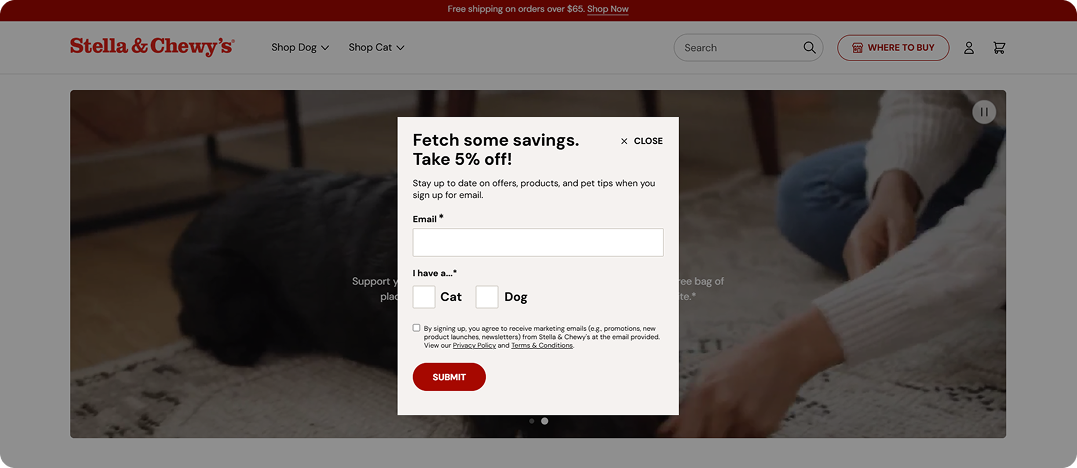
A discount is the best incentive to make people sign up for your email list
A good offer gives people the push they need to subscribe and helps you attract people who care about what you're offering.
3. Send a welcome email right away
As soon as someone subscribes, send a welcome email to introduce yourself, explain what they can expect, and give them the promised incentive (like a discount or free resource).
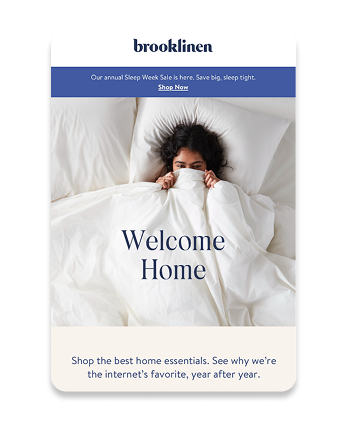 Using your signature tone of voice in welcome emails helps people understand what your brand is all about right away
Using your signature tone of voice in welcome emails helps people understand what your brand is all about right away
Welcome emails have high open rates, so use this chance to introduce your brand, set expectations, and make a strong first impression. Also, let people know what kind of emails they’ll receive, how often, and any next steps they should take.
4. Keep your subscribers interested
Getting people to sign up is just the start; keeping them engaged is key. If your emails aren’t useful, people will stop opening them. Make sure each email offers something valuable, like discounts, early product drops, behind-the-scenes insights, or useful tips.
Stay consistent so they don’t forget about you, but don’t overdo it. Too many emails can get annoying, and too few can make them lose interest — find a rhythm that keeps them looking forward to what’s next.
5. Personalize
Your email list isn’t one-size-fits-all, so your emails shouldn’t be either. Some people are first-time subscribers, while others have already bought from you. Some might love your emails and open every one, while others barely engage.
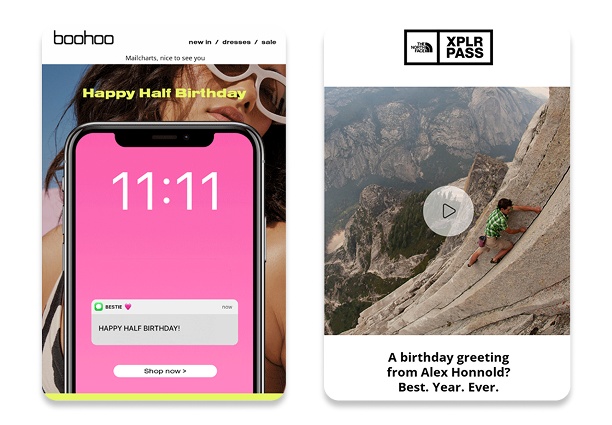
Sending a birthday email with a special something from your brand is one of the easiest ways to make your emails more personalized
Segmentation matters, so group your audience based on location, demographics, past purchases, or how often they interact with your emails. This way, you can send personalized offers, recommendations, and updates that actually matter to each group.
Once your list is built, it’s time to send emails. But how do you ensure you’re sending the right messages to the right people?
Let’s talk about some tips and tricks for running effective email marketing campaigns.
Best practices for email marketing campaigns
Getting people to open your email is just the first step. The real challenge is keeping them engaged and leading them to take action.
A good marketing email should be easy to read, interesting, and useful to your audience. Here’s how to write emails that grab attention and get results:
1. Write a catchy subject line
Your subject line is your first (and maybe only) shot at grabbing attention. Make it stand out and spark curiosity so people want to open your email.
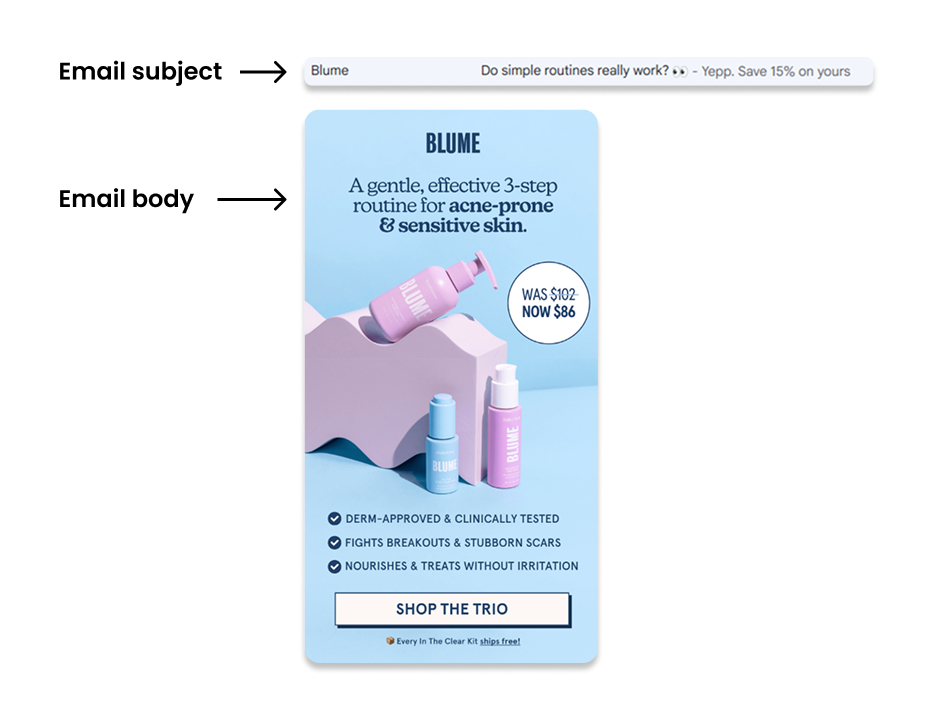
Using questions in subject lines is one of the best ways to make people curious about the email's contents
Here's how to make sure it does:
- Personalize it by including the recipient's name or even their location to instantly make the email feel more relevant and personal. For example, “John, your exclusive 24-hour shoe deal is here” works better than a generic subject line like "Big Sale on Shoes Now."
- Spark curiosity by asking a question, teasing something valuable, or creating a sense of urgency. For instance, something like “Want to save 50% on your next purchase?” or “Hurry, the offer ends at midnight!” will trigger urgency to act quickly.
- Keep it under 50 characters so it doesn’t get cut off. A concise subject is easier to read and can help avoid getting lost in someone’s inbox.
- Avoid spammy words like “free,” “urgent,” or “act now” as they can trigger spam filters and send your email straight to junk. Instead, focus on creating intrigue with clear, helpful language that reflects the value of your email.
A great subject line means more people open your email — so make it count.
2. Start with a strong opening
The beginning of your email should grab attention right away and flow naturally from your subject line. You want to hook your reader so they’re eager to keep going.
Here’s how to make that happen:
- Ask a question to make the reader think about their own situation and get them curious about what comes next. Example: “Tired of wasting time on tasks that could be automated?”
- Make a bold statement — lead with something surprising or interesting that sparks curiosity. Example: "This one simple tweak could skyrocket your sales — find out how".
- Highlight a benefit to let people know what’s in it for them, i.e. how your email can help solve their problem or meet their needs. Example: “We can help you grow your business without any extra effort on your part.”
These small tweaks keep readers hooked and eager to read more.
3. Make your emails visually appealing
People skim emails, so make yours easy to read and visually appealing. Here’s how to do it:
- Use short paragraphs and white space to keep things light and easy on the eyes. Large blocks of text can overwhelm your reader and make them scroll past.
- Add images or GIFs to make your email more interesting and give it personality. Just make sure they add value and aren’t distracting.
- Stick to consistent branding (brand colors, fonts, and logos) to create a cohesive and recognizable look. This helps your email feel professional and tied to your business.
- Make it mobile-friendly to adapt to smaller screens. Keep everything easy to click and readable without zooming in.
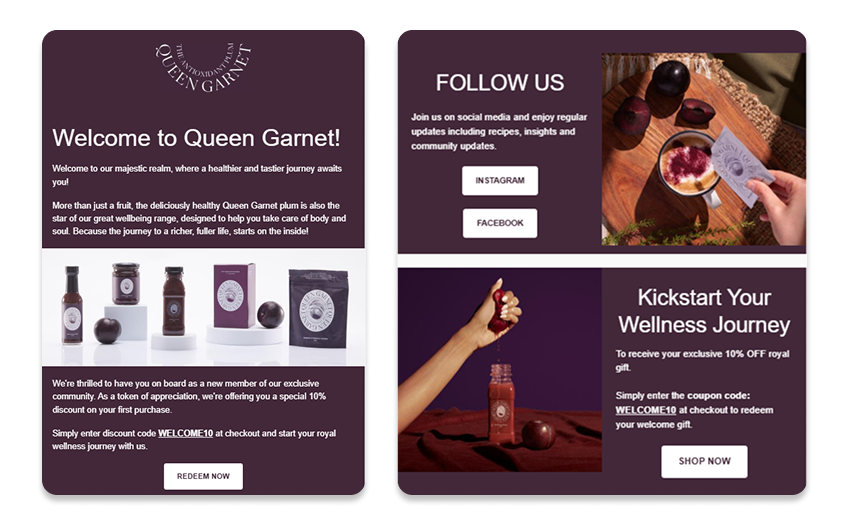 This email ticks all the boxes: it's readable, includes great visuals that don't overwhelm, has a consistent color palette, and visible CTA buttons
This email ticks all the boxes: it's readable, includes great visuals that don't overwhelm, has a consistent color palette, and visible CTA buttons
A well-designed email doesn’t just look nice — it makes your content easier to digest and more enjoyable to read.
5. Use a conversational tone
Emails shouldn’t feel like a corporate announcement, so write like you’re talking to a friend — keep it clear, casual, and engaging.
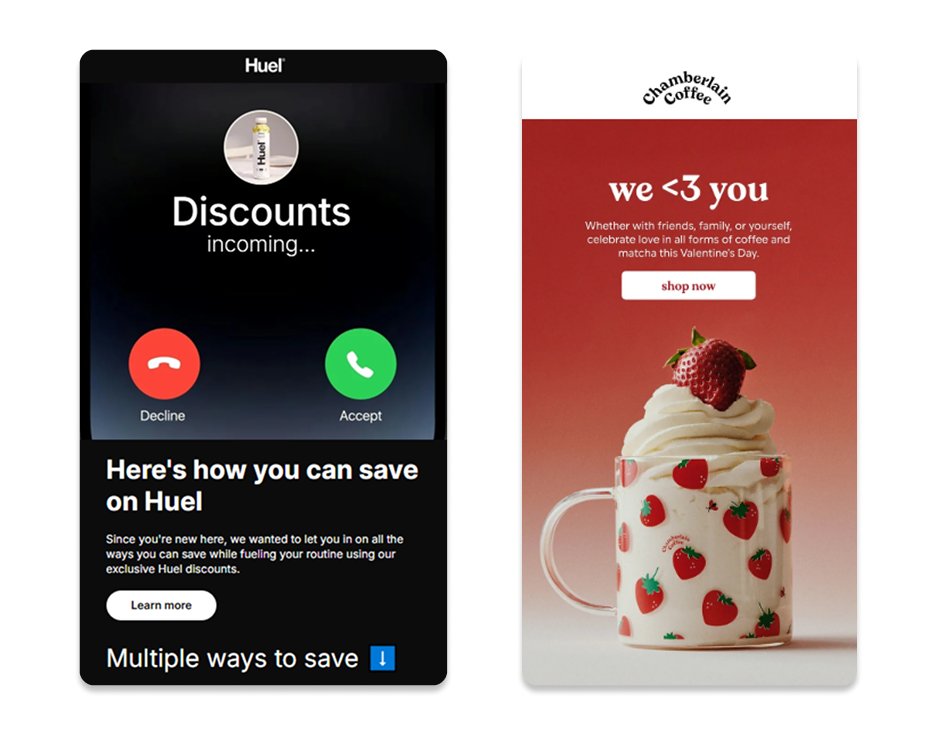 Conversational style can easily turn your emails from boring to fun and engaging
Conversational style can easily turn your emails from boring to fun and engaging
For example, instead of "Our company is pleased to offer an exclusive promotional discount", use "We’ve got something special for you”. This tone will help readers feel like they’re having a one-on-one conversation with a brand they trust, which can make them more likely to open the email and take action.
6. Add storytelling and social proof
People connect with stories, so sharing real examples can be a lot more effective than just listing features.
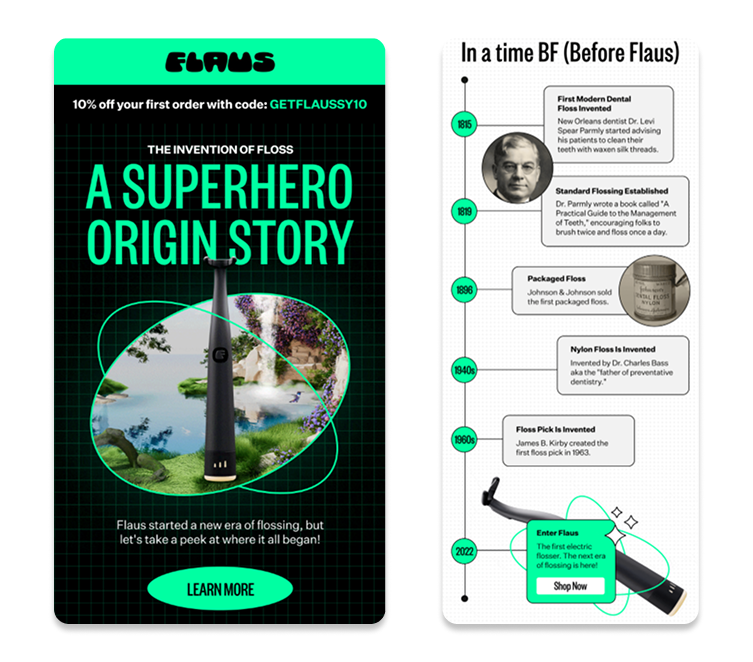 There are many stories you can tell through email, including your brand's story
There are many stories you can tell through email, including your brand's story
For example, you can start with a story telling about how your product helps people solve real issues: "Emma hated meal planning, but after joining our recipe subscription, dinner's a breeze. Now she has more time with her family. Want to see how it can help you too?".
Using social proof like customer reviews, testimonials, or success stories can also help: this builds trust and shows that others are loving what you offer.
7. Include a strong Call to Action (CTA)
Every email should have a clear goal, and your CTA is how you make that happen. It should make it super clear what action you want people to take: buy something, sign up for an event, grab a free resource, etc.
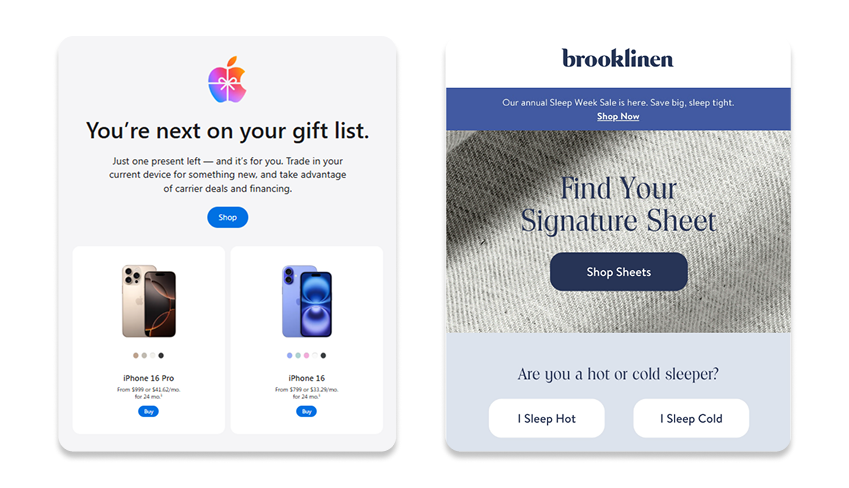
A clear and concise CTA button together with a relevant offer is a match made in heaven
Here’s how to do it right:
- Use action-driven phrases like “Shop Now,” “Get Your Free Guide,” or “Claim Your Discount”.
- Make it stand out — use bold text, buttons, or bright colors to make your CTA more noticeable.
- Place it strategically in the beginning for easy access and at the end so people don’t have to scroll back up to find it.
A simple, bold, and easy-to-find CTA button makes it more likely that people will take the action you want.
8. Send emails from a real person
People tend to ignore emails that come from a “no-reply” address or something that feels automated. To make your emails feel more personal, use a real person’s name as the sender.
For example, instead of “Brand XYZ” as your email signature and “no-reply@yourbusiness.com” as the email address, send emails as “Jane from [your brand]” from a corresponding address to make it clear that a real person is behind the message.
9. Automate follow-ups
One email isn’t always enough — sometimes, people need a few reminders. Automated email sequences are here to help: it’s a great way to nurture leads, recover abandoned carts, and re-engage inactive subscribers without overwhelming anyone.
Here’s an example:
- First, send a reminder email: “Still thinking about it? [Product] is waiting”.
- Next, offer an incentive: “Complete your purchase today and get 20% off”.
- Finally, create a sense of urgency: “Last chance — your discount will expire soon”.
The key is to space the emails out so you’re not bombarding your subscribers. Keep it timely and relevant, and they’ll appreciate the reminders without feeling like they’re being spammed.
10. A/B test your emails
Think of A/B testing as trial and error for your emails — it shows you what works best. You can test different elements like:
- Subject lines: which ones make people want to open the email?
- CTA placement: does your CTA button perform better at the top or bottom of the email?
- Email design: do people engage more when your emails have images, or is a simple layout more effective?
- Send times: are your subscribers more likely to open your email in the morning or evening?
By watching what your audience responds to, you can tweak your emails to make them more engaging and improve conversions as time goes on.
11. Follow email compliance regulations
Breaking email laws like CAN-SPAM or GDPR can get your emails flagged — or worse, fined. Here’s how to keep everything above board:
- Get permission before adding people to your email list.
- Make the unsubscribe button easy to find so people don’t have to look for it.
- Avoid misleading subject lines — explain clearly what your email is about.
- Include your business address in the footer of every email so people know how to contact you.
This will help you protect your reputation and maintain trust with your audience.
12. Track email marketing KPIs
To make sure your email campaigns are hitting the mark, you need to keep track of how they’re doing. Keep an eye on these KPIs:
- Open rate: are people opening your emails? If not, maybe your subject lines or timing need a bit of a makeover.
- Click-through rate: are people clicking on your links? If it’s low, you might need to make your content or call-to-action more compelling.
- Conversion rate: are people taking the action you want them to? If not, it might be time to rethink your offer or CTA.
- Unsubscribe rate: are people unsubscribing too often? If this number is high, it could mean you're sending too many emails or the content isn’t particularly relevant.
Tracking these metrics helps you refine your strategy and send better emails. The goal is to make sure every campaign gets a little better, so you can keep growing your email list.
Recap
Email marketing is one of the most powerful tools in your arsenal if you do it right. It’s not just about hitting “send” and hoping for the best. It’s about knowing your audience, personalizing your messages, and constantly refining your strategy to improve engagement.
By using the right email types for the right occasion, growing your email list, and following best practices, you’ll turn your email campaigns into a high-converting, relationship-building strategy.
Now, it’s time to put these insights into action — your next great email campaign is just an inbox away.

